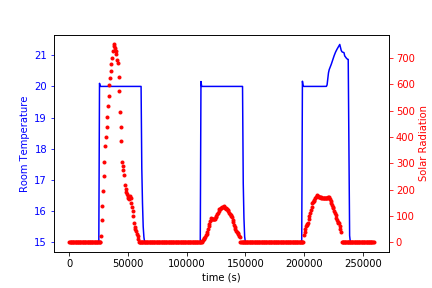I recently started developing a large-scale building simulation and optimization framework based off the work of the IEA EBC Annex 60 (now continuing as IBPSA Project 1). This led me to using EnergyPlusToFMU to convert an EnergyPlus model into a Functional Mock-up Unit (FMU). I couldn’t find any examples using JModelica and PyFMI with EnergyPlus so I thought I’d write one.
System setup
Platform: Ubuntu 16.04
JModelica: 2.2+ (trunk)
python -V: Python 2.7.12 (64 bit)
energyplus -v: 8.9.0-40101eaafd
compilation target: 64 bit (from EnergyPlusToFMU-v2.0.3/Scripts/linux/test-c-exe.sh)
Testing .idf file: EnergyPlusToFMU-v2.0.3/Examples/Variable/_fmu-export-variable.idf
Making an EnergyPlus FMU
First, increment the version of _fmu-export-variable.idf from 8.5 to 8.9 with successive application of IDFVersionUpdater scripts, first being 8.5 to 8.6, continue until the .idf file is version 8.9.
Note: where ever
$ <path>/EnergyPlus-8-9-0/PreProcess/IDFVersionUpdater/Transition-V8-5-0-to-V8-6-0 \
_fmu-export-variable.idf
Next use the EnergyPlusToFMU python script to make the EnergyPlus.fmu
$ python <path>/EnergyPlusToFMU-v2.0.3/Scripts/EnergyPlusToFMU.py \
-i V8-9-0-Energy+.idd \
-w USA_IL_Chicago-OHare.Intl.AP.725300_TMY3.epw \
_fmu-export-variable.idf
Now the .fmu file can be checked with the FMU compliance checker. Make sure FMUComplianceChecker is built correctly for your platform first.
$ <path>/FMUComplianceChecker/build/fmuCheck.linux64 -h 600 -s 86400 _fmu_export_variable.fmu
the -h specifies the step size in seconds, -s is the stop time in seconds. The compliance checker gave me errors until I added the stop time being a multiple of 86400. The step size needs to be the same as the .idf file specifies, i.e. in _fmu-export-variable.idf (line 101):
Timestep,6;
This is specified in steps per hour, so 6 steps/h = 600s per step.
Simulating EnergyPlus FMU with JModelica and PyFMI
The main difficulty I had was making the number of communication points (ncp) match up given the final_time. I ran this in JupyterLab (.ipynb) but it should work in ipython or in a .py script.
The output chart should look something like this:

This should generalize to more complicated EnergyPlus models with more states, inputs, and outputs allowing for intergration with larger building simulation and optimization toolchains.
